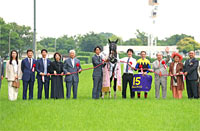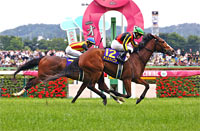Yushun Himba (Japanese Oaks)(G1) - Data Analysis
Gala showcase for 3yo fillies carrying the future of Japanese racing
As Japan’s top contest for three-year-old fillies, the Japanese Oaks has a history of strong performances not only by fillies that have enjoyed successful careers but also by a long line of broodmares that have themselves produced outstanding racehorses. Just looking at the Top 2 finishers since 1984, when the grade system was introduced, seven of them - Yu Miroku (Gokai, Yu Fuyoho), Agnes Flora (Agnes Flight, Agnes Tachyon), Vega (Admire Vega, Admire Don), Air Groove (Admire Groove), Air Deja Vu (Air Messiah), Rosebud (Rose Kingdom) and Cesario (Epiphaneia, Leontes) - have produced future winners of JRA G1 races (including jump races) as of December 31, 2016. Let’s now analyze some trends in this important race, so closely tied to the future of Japanese racing, from results over the last 10 years.
Successful runners tend to have contested G1 or G2 races last time out
Of the 30 Top 3 finishers over the last 10 years, 27 had most recently contested a “G1 or G2” race. By contrast, runners coming straight from races with “Other conditions” have struggled, managing a Top 3 ratio of just 5.7%. Our expectations of fillies most recently seen in G3, Open-class, or other allowance-class races should not be too high. [Table 1]
[Table 1] Performance by condition of previous race (last 10 years)
| Condition of previous race |
Performance
[1st-2nd-3rd-4th or lower] |
Win ratio |
Top 2 ratio |
Top 3 ratio |
| G1 or G2 |
9-9-9-98 |
7.2% |
14.4% |
21.6% |
| Other conditions |
2-0-1-50 |
3.8% |
3.8% |
5.7% |
Note: Two runners tied for 1st in 2010.
Moreover, of runners over the last 10 years most recently seen in “G1 or G2” races, those finishing “In the Top 2” in that race have enjoyed outstanding success here, with a Top 3 ratio of 51.4%. It seems we can place our trust in fillies most recently seen in higher grade races and coming home among the first two in that race. [Table 2]
[Table 2] Performance by finish in the previous race when it was “G1 or G2” (last 10 years)
| Finish in previous race |
Performance
[1st-2nd-3rd-4th or lower] |
Win ratio |
Top 2 ratio |
Top 3 ratio |
| In the Top 2 |
5-7-6-17 |
14.3% |
34.3% |
51.4% |
| 3rd or lower |
4-2-3-81 |
4.4% |
6.7% |
10.0% |
Note: Two runners tied for 1st in 2010.
Incidentally, of horses most recently seen in races other than “G1 or G2” over the last 10 years, no runner finishing “3rd or lower” in that race has had any success here. Fillies coming straight from G3 or lower condition races need to have finished in the Top 2 in that race to have any chance of success here, it seems. [Table 3]
[Table 3] Performance by finish in the previous race when it was not “G1 or G2” (last 10 years)
| Finish in previous race |
Performance
[1st-2nd-3rd-4th or lower] |
Win ratio |
Top 2 ratio |
Top 3 ratio |
| In the Top 2 |
2-0-1-38 |
4.9% |
4.9% |
7.3% |
| 3rd or lower |
0-0-0-12 |
0% |
0% |
0% |
Note: Two runners tied for 1st in 2010.
Performance in graded races since the turn of the year is important
Of 30 Top 3 finishers over the last 10 years, 25 had previous experience of a Top 2 finish in “JRA graded races in the same year.” Horses without this experience not only have a low Top 3 ratio of 5.6%, but have not finished in the Top 2 here since 2012. We should probably avoid runners with no experience of vying for victory in graded races, as well as those that have only succeeded in graded races as 2-year-olds. [Table 4]
[Table 4] Performance by experience of a Top 2 finish in “JRA graded races in the same year” (last 10 years)
| Experience of Top 2 finish |
Performance
[1st-2nd-3rd-4th or lower] |
Win ratio |
Top 2 ratio |
Top 3 ratio |
| Yes |
9-8-8-63 |
10.2% |
19.3% |
28.4% |
| No |
2-1-2-85 |
2.2% |
3.3% |
5.6% |
Note: Two runners tied for 1st in 2010.
Again, of the 30 Top 3 finishers over the last 10 years, 27 had previous experience of Top 4 favoritism in “JRA graded races in the same year.” These 27 also have excellent success ratios, including a Top 3 ratio of 31.0%. When checking performances in graded races since the turn of the year, we should pay attention both to the finish and to the favoritism at the time. [Table 5]
[Table 5] Performance by experience of Top 4 favoritism in “JRA graded races in the same year” (last 10 years)
| Experience |
Performance
[1st-2nd-3rd-4th or lower] |
Win ratio |
Top 2 ratio |
Top 3 ratio |
| Yes |
10-8-9-60 |
11.5% |
20.7% |
31.0% |
| No |
1-1-1-88 |
1.1% |
2.2% |
3.3% |
Note: Two runners tied for 1st in 2010.
Front runners last time out fare poorly here
Of 30 Top 3 finishers over the last 10 years, 27 had been positioned “4th or lower” when passing the 4th corner in their previous race. Conversely, those positioned “3rd or higher” at that point have only managed a Top 3 ratio of 7.3%; the only one to achieve a Top 2 finish here was the 2010 winner Saint Emilion. We should perhaps discount horses that led the pack last time out, even if they are highly favored in the betting. [Table 6]
[Table 6] Performance by position at 4th corner last time out (last 10 years)
| Position at 4th corner last time out |
Performance
[1st-2nd-3rd-4th or lower] |
Win ratio |
Top 2 ratio |
Top 3 ratio |
| 3rd or higher |
1-0-2-38 |
2.4% |
2.4% |
7.3% |
| 4th or lower |
10-9-8-110 |
7.3% |
13.9% |
19.7% |
Note: Two runners tied for 1st in 2010.
Shorter careers providing best performances recently
Of 15 Top 3 finishers over the last five years, 12 came with “5 or fewer” previous career starts. Runners with “6 or more” previous starts have a poor Top 3 ratio of 6.1%; the only one to finish in the Top 2 was the 2013 winner Meisho Mambo (6 previous career starts). If recent trends are anything to go by, we should be focusing on runners coming to this race with 5 or fewer career starts, rather than those with more abundant racing experience. [Table 7]
[Table 7] Performance by cumulative career starts (last 5 years)
| Cumulative career starts |
Performance
[1st-2nd-3rd-4th or lower] |
Win ratio |
Top 2 ratio |
Top 3 ratio |
| 2 or fewer |
0-0-0-2 |
0% |
0% |
0% |
| 3 |
0-0-1-4 |
0% |
0% |
20.0% |
| 4 |
2-3-2-10 |
11.8% |
29.4% |
41.2% |
| 5 |
2-2-0-12 |
12.5% |
25.0% |
25.0% |
| 6 |
1-0-1-17 |
5.3% |
5.3% |
10.5% |
| 7 |
0-0-1-11 |
0% |
0% |
8.3% |
| 8 or more |
0-0-0-18 |
0% |
0% |
0% |
| 5 or fewer |
4-5-3-28 |
10.0% |
22.5% |
30.0% |
| 6 or more |
1-0-2-46 |
2.0% |
2.0% |
6.1% |
Seek out the winner!
Focus on horses with more positives
All of the last five winners had experienced a Top 2 finish in a JRA graded race that year. Other features shared by these five are that they had all experienced Top 4 favoritism in JRA graded races in the same year, had passed the 4th corner last time out in 7th position or lower, and had six or fewer previous career starts. Any runner clearing many of the conditions connected with previous races - particularly those in Table 4, Table 5, Table 6 and Table 7 above - must be a leading contender. [Table 8]
[Table 8] “Highest finish in JRA graded races in the same year,” “Highest favoritism in JRA graded races in the same year,” “Position at 4th corner last time out,” and “Cumulative career starts” of winning horses (last 5 years)
| Year |
Winning horse |
Highest finish in JRA graded races in the same year |
Highest favoritism in JRA graded races in the same year |
Position at 4th corner last time out |
Cumulative career starts |
| 2012 |
Gentildonna |
1st (Oka Sho, etc.) |
2nd favorite (Oka Sho, etc.) |
10th position |
5 |
| 2013 |
Meisho Mambo |
1st (Hochi Hai Fillies’ Revue) |
3rd favorite (Hochi Hai Fillies’ Revue) |
7th position |
6 |
| 2014 |
Nuovo Record |
2nd (Tulip Sho) |
4th favorite (Tulip Sho) |
12th position |
5 |
| 2015 |
Mikki Queen |
2nd (Daily Hai Queen Cup) |
3rd favorite (Daily Hai Queen Cup) |
7th position |
4 |
| 2016 |
Sinhalite |
1st (Tulip Sho) |
2nd favorite (Oka Sho, etc.) |
8th position |
4 |
(Masaya Ibuki)
|




















